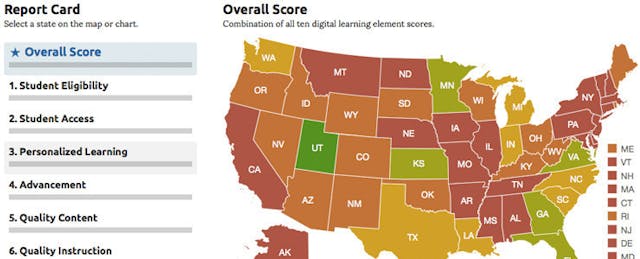The second annual Digital Learning Report Card is out, grading significant policy decisions (on a state-by-state basis) which "are advancing student-centric reforms, reducing barriers to blended learning, and encouraging the use of technology to offer a more personalized college- and career-ready education." The Report Card is courtesy of Digital Learning Now, the advocacy/research group spearheaded by former Fla. governor, Jeb Bush.
The winners? Well a mere six of the 50 states -- Utah, Florida, Georgia, Minnesota, Virginia, and Kansas -- received grades higher than a 'C'. But as every good educator and ed-reformer knows, any assessment is only as good as the metrics that you measure. In this case, those metrics come in the form of the 10 Elements of High Quality Digital Learning and the 39 supporting metrics.
Many of the Elements are likely to draw a strong thumbs-up consensus. Improving access and equity, increasing digital content and instructional quality, and moving towards competency-based learning are goals with few detractors in the ed reform or edtech space. But a closer look at the supporting metrics suggests that state's Report Cards are not easily boiled down to simple letter grades -- even if that's the de facto process for reviewing students' academic performance.
Not surprisingly, many of the supporting metrics read like preferred business conditions for edtech companies. That's probably okay, even desirable, considering how many innovative companies are struggling to gain a foothold in traditional education markets. But as is normally the case with policy analysis, the devil lurks in the details.
Take for example, the metrics supporting Element 1: "Student Eligibility." Should all students "be provided opportunities to access online courses throughout their entire K-12 experience?"
Absolutely.
But should all students be required to "complete at least one online course to earn a high school diploma?"
Well, perhaps. Require is a strong word. And what exactly is an "online course?" At least for the first four Elements of High Quality Digital Learning, it appears that digital learning is limited in scope to for-credit online courses -- a distinct departure from the wide-ranging "digital content" described in the introduction.
It may very well be a matter of semantics, but narrowing policy decisions to only include this type of digital learning (no matter how effective) eliminates an entire canon of web 2.0/3.0 and supplemental tools from the prescribed legislative benefits.
"Course" definitions aside, the metrics supporting the other Elements comprise a respectable framework for evaluating edtech policy decisions. Less restrictive seat time requirements, more student devices, updated procurement and approval processes, alternative teacher certifications, and student choice (of content) are all hot button topics that state legislators should be addressing but--at least according to the Report Card-- they are largely failing to act upon.
Perhaps most radical of metrics are found beneath Element 9: Funding. The 30th metric states:
Public funds are available for online learning to: a. all district public school students. b. all charter public school students. c. all private school students. d. all home education students.
The 34th metric goes even further:
The same per-pupil funding with the same payment process is provided to all virtual charter schools, full-time online schools, and individual online course providers, regardless of whether the school is public, charter, not-for-profit, or for-profit.
At first glance (and even second or third), such bold demands to de-regulate public school funding systems is downright scary, especially for those physical schools struggling with current per-pupil funding. But administrators at those same struggling schools will concede that the merits of the current system are few and far in-between. Element 9 and its supporting metrics, at a minimum, are a starting point for considering new funding systems in a digital world.
The metrics supporting Element 10 (infrastructure) are mostly obvious -- high speed broadband and devices for all -- but they highlight a hidden gem, the Data Quality Campaign's 10 State Actions to Ensure an Effective DataUse. To date, no state has performed all ten actions which describe (in painstaking detail) the various data migration, integration, and warehousing efforts required for education stakeholders to effectively utilize student data.
The final grade for the Digital Learning Report Card itself is a solid B+. There will surely be some disagreements over the courses of action championed throughout, but the issues which it highlights are right on par with those faced in schools and classrooms across the country.


